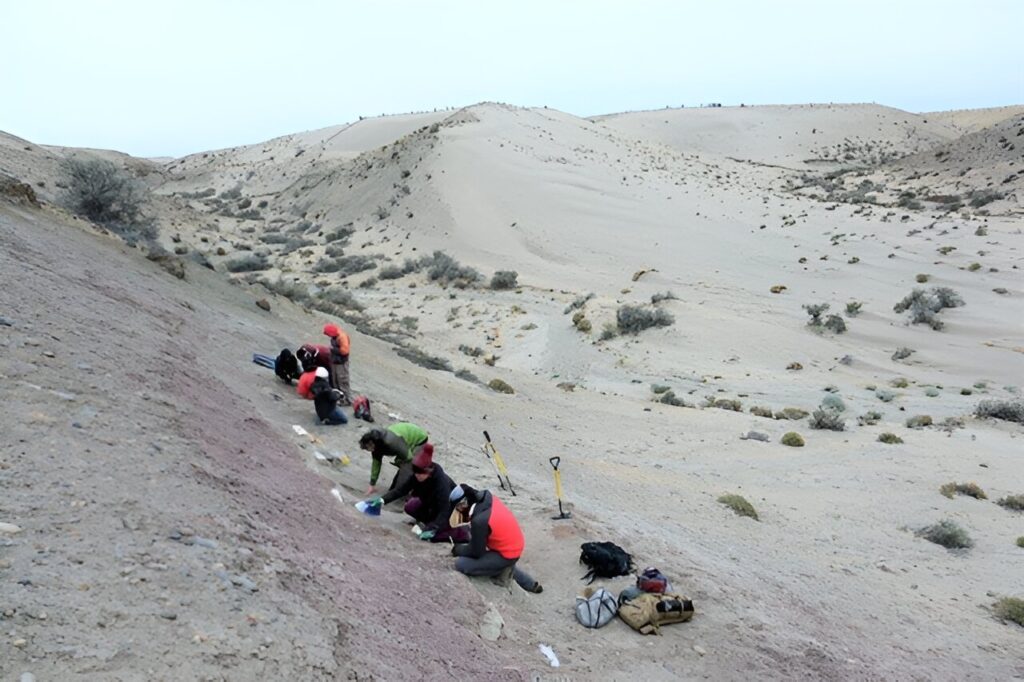The unveiling of a captivating fossil site in the heart of Argentina is not merely an archaeological revelation; it is an expedition that promises to reshape our understanding of the closing chapters of the Cretaceous period. Just on the cusp of the non-avian dinosaurs’ eventual demise, this epoch is brought to life through pioneering research, set to be showcased at the forthcoming Geological Society of America’s GSA Connects 2023 meeting on the 16th of October.
The maestro behind this ground-breaking venture is none other than Matthew Lamanna, a distinguished paleontologist who stands as the principal dinosaur researcher at the renowned Carnegie Museum of Natural History. Together with his devoted team, Lamanna is unravelling an astonishing tale of prehistoric life.

Their journey takes them to the Cañadón Tomás Quarry, a site tucked away in the southern reaches of Argentina’s Patagonia region. It’s here that a treasure trove of ancient remnants has been uncovered, waiting to tell the story of a bygone era. Lamanna elucidates the striking discrepancy in our knowledge of Cretaceous continental vertebrates between the Northern and Southern Hemispheres.
This gap in our comprehension, he argues, has implications that stretch beyond the academic realm, affecting our perception of biodiversity, evolution, and the intricate web of paleobiogeography. Consequently, his team endeavors to address a pivotal question: How did the non-avian dinosaurs in the southern reaches of the world navigate the challenging terrain of the Cretaceous-Paleogene boundary?
This remarkable journey begins its origin story back in the early days of 2020 when petroleum exploration ventures put the Cañadón Tomás site on the map. Oil companies, as mandated by regulations, were obligated to conduct a comprehensive paleontological impact study before commencing their work. In the course of this assessment, dinosaur fossils were unearthed, sparking a series of revelations that have since reshaped our understanding of prehistoric life in the Southern Hemisphere.
Noelia Cardozo, an intrepid Ph.D. student at the Universidad Nacional de la Patagonia San Juan Bosco (UNPSJB) and an integral member of the Cañadón Tomás research team, delves into the site’s origin story. She describes the initial discovery of hadrosaur bones, the colossal duck-billed dinosaurs. This momentous revelation was a torchbearer for the team, motivating them to launch a comprehensive excavation effort with hopes of uncovering more of these fossilized treasures.
Subsequent expeditions have unearthed an impressive array of hadrosaur bones. While these herbivorous giants are well-documented in Northern Hemisphere Late Cretaceous sites, their presence in the Southern Hemisphere remains a tantalizing enigma. The fascinating twist to this tale lies in the diversity of sizes represented by the hadrosaur fossils. This curious observation prompts questions about the possibility of a social group or even a familial herd, igniting the team’s curiosity and prompting further exploration.
Intriguingly, the team’s archaeological endeavors have led to the discovery of remains from two non-avian predatory dinosaurs: a tooth, likely from an abelisaurid, and a claw, possibly from a noasaurid or a young abelisaurid. These findings paint a vivid portrait of the intricate ecosystems that thrived during the Late Cretaceous period in the Southern Hemisphere.
Yet, as captivating as the dinosaur fossils are, it is the uncovering of small-bodied vertebrates that has set the research community abuzz with excitement. Among the remarkable discoveries, a snake vertebra, likely from a madtsoiid, marks the first-ever Cretaceous snake to emerge from the Golfo San Jorge Basin in Patagonia. This find is remarkable not only for its rarity but also for the broader insights it offers into the region’s ancient biodiversity.
Another revelation that has left the scientific community in awe is the discovery of the upper jaw containing teeth of a small mammal known as a reigitheriid. This find, unexpected and exceptional, opens a new chapter in the paleontological narrative. Cardozo, who had the privilege of uncovering this relic, expresses her astonishment at the discovery, given the site’s primary association with dinosaurs.
The significance of this find lies in its ability to provide a more complete picture of the Cretaceous world, offering a glimpse into the lives of small mammals that coexisted with the formidable dinosaurs.
The journey of discovery at Cañadón Tomás reached a momentous milestone in March 2023 when Cardozo, along with fellow UNPSJB student Ivanna Mora, made an astonishing find. In a mere two hours of sieving through rocks and sediment, they unearthed the jaw fragment of the small mammal—an extraordinary feat in the realm of paleontology.
The fossil now stands as a testament to their dedication and meticulous exploration, marking the first Cretaceous mammal of any kind discovered in the Golfo San Jorge Basin. Lamanna is effusive in his praise, hailing the fossil as one of the most exceptional specimens of its kind to ever be unearthed.
Mammals of the Cretaceous era were often diminutive, reminiscent of rodent-sized creatures, dwarfed by the colossal presence of the dinosaurs. However, delving into the world of these small mammals is indispensable for achieving a comprehensive understanding of the Cretaceous period, leading up to the non-avian dinosaur extinction and the subsequent rise of mammals.
While the research and excavations at Cañadón Tomás are in their initial stages, the preliminary findings underscore the site’s immense potential. UNPSJB Ph.D. student Bruno Alvarez underscores the site’s importance, emphasizing the staggering diversity and abundance of materials discovered. As excavation work continues, the team anticipates the unveiling of even more fossils, promising fresh revelations and insights into the past.
Lamanna’s enthusiasm for the project is palpable as he encourages the world to keep a watchful eye for upcoming discoveries from Cañadón Tomás. He anticipates that the site harbors the potential to not only illuminate our understanding of Cretaceous-Paleogene faunal dynamics and extinction patterns in the Southern Hemisphere but also to reveal new species of animals yet to be documented.
For Lamanna, this is one of the most exhilarating and promising projects, a journey of discovery that promises to rewrite the annals of paleontology and redefine our comprehension of the prehistoric world.
